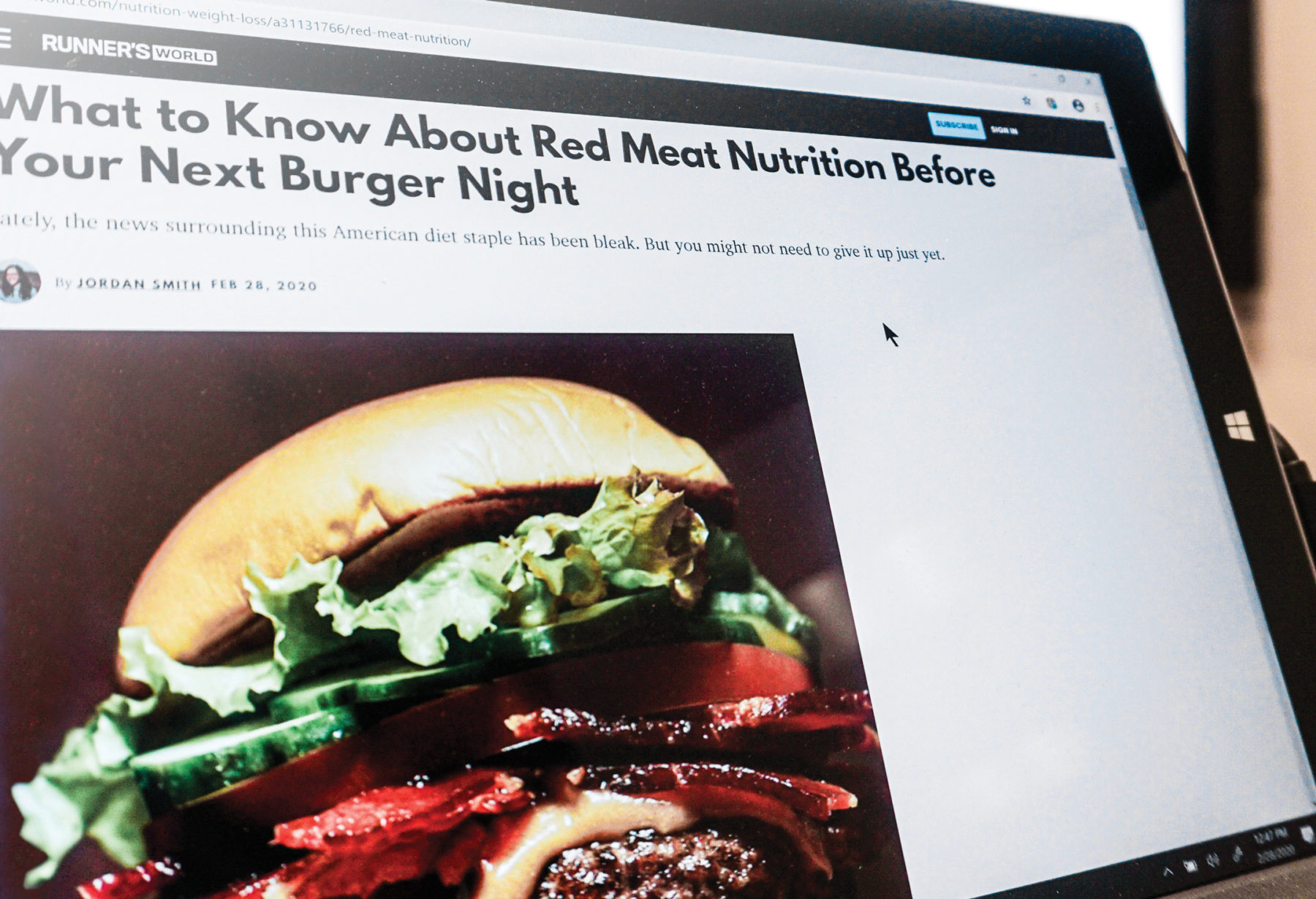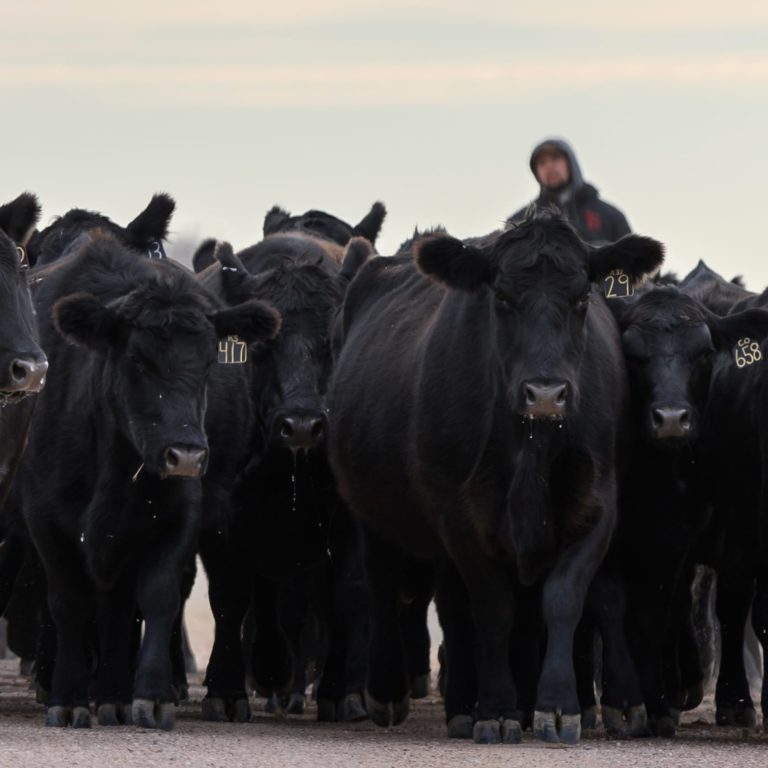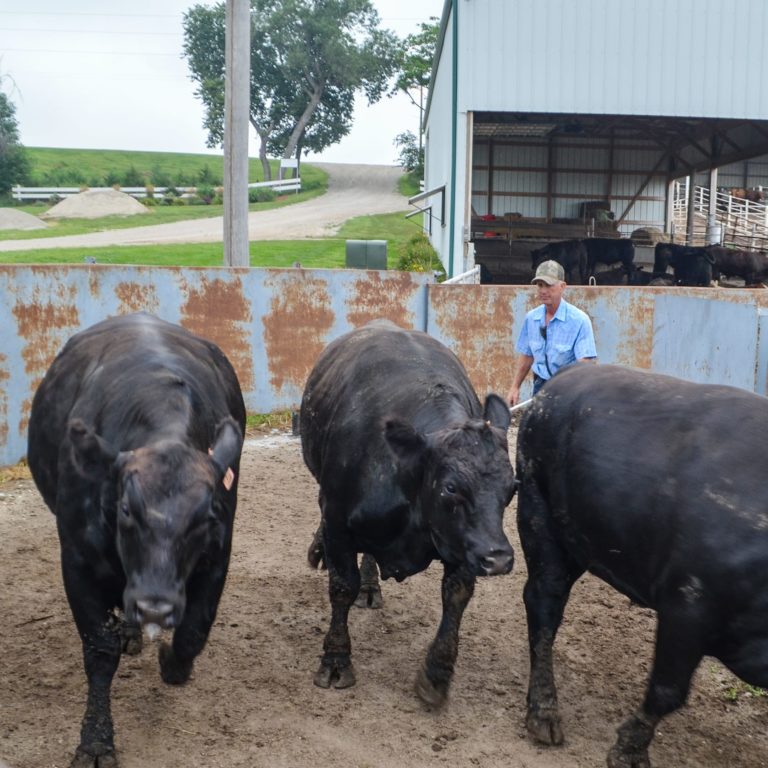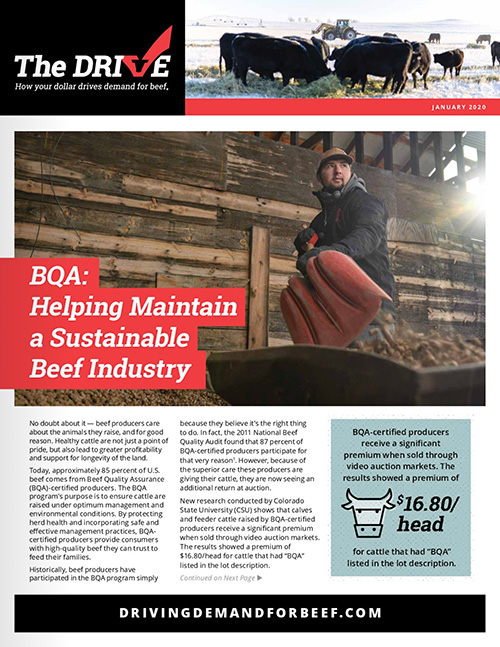
Monitoring Meat
Flickering cable news shows speed across multiple large television screens along one wall, while several sets of watchful eyes glance over a series of computers scrolling through traditional and social media sites. The atmosphere is a combination of Times Square, a military operations room and the TV section at Target. This is the Digital Command Center, home of the Checkoff-funded Issues Management and Media Relations team at the National Cattlemen’s Beef Association (NCBA).
This team of savvy communications professionals works every single day to protect the consumer and marketing environment for beef. Charged with actively monitoring important conversations and issues threatening consumer confidence in beef, this team is the Beef Checkoff’s minute-by-minute watch dog for the beef industry, addressing myths that make people question beef and offer immediate fact-based responses to issues and trending topics.
DIGITAL COMMAND CENTER
An extremely sophisticated monitoring operation, the Digital Command Center serves as the hub for the beef industry’s media monitoring and response needs. Twenty-four hours a day, seven days a week, the team utilizes the command center to actively monitor more than 200 beef-related topics ranging from dietary guidelines to sustainability claims, and from meat substitutes to animal welfare.
“Our team meets every single morning to look at the news stories of the day that could potentially impact beef and determine if there is anything we need to do in response,” says Jenn Tilliss, NCBA’s executive director for the Issues Management and Media Relations team. “We also look at trends so we can plan accordingly with issues response and try to get ahead of situations.”
The Digital Command Center is so refined in its technology that team members receive a notification when a topic hits a certain threshold, which could be the number of people it’s reached, the number of stories being circulated about a particular topic or other measures. This allows the team to react quickly, including outside of business hours.
MEAT SUBSTITUTES IN THE MEDIA
NCBA has had meat substitutes on its radar for quite some time, and it’s executing multiple initiatives to ensure consumers, influencers, supply chain and the media have the facts about how these substitutes compare with beef.
For example, the checkoff-funded Beef. It’s What’s For Dinner. digital campaign, “Nicely done, beef.” ads executed by NCBA directly addresses misinformation and highlights beef’s strongest attributes. A single ad stating “Nicely done, beef. You’ve proven that meat substitutes are just that. Substitutes.” has had more than 53 million impressions and has resulted in more than 286,000 clicks back to the BeefItsWhatsForDinner.com website 1.
In November 2019, a meat substitute company that manufactures a soy-based burger commented on a Beef. It’s What’s For Dinner. Twitter post featuring a video of the Beef Holiday Drool Log saying, “Okay, boomers.” This patronizing statement is basically a social media insult used by Millennials and Generation Z to express frustration with older generations and their “outdated” beliefs or preferences. The NCBA team took it as an opportunity to defend the Beef. It’s What’s For Dinner. brand and posted a response that said, “Don’t be so salty… oh, wait….” This response highlighted the fact that meat substitutes are high in sodium. The response had a reach of more than 160,000 and more than 24,000 impressions, 70-plus retweets and 400-plus likes 2. The meat substitutes company hasn’t responded again.
A series of fact sheets and information available on BeefItsWhatsForDinner.com also gives a look into the nutritional breakdown and ingredient lists of beef products compared to those of meat substitutes. Realizing consumers may be looking for more information about meat substitutes, a Google search campaign delivers Beef. It’s What’s For Dinner. ads to consumers who search for these substitutes online. Also, 350 retail and foodservice professionals were shown how beef stacks up to meat substitutes in an educational webinar.
TOP-OF-MIND ISSUES MANAGEMENT
NCBA uses a proactive messaging strategy to stay ahead of issues that could potentially impact consumer perceptions about the beef industry. For example, according to market research insights, many consumers are concerned about animal welfare during the beef production process. To answer those concerns, the NCBA team shared the formerly producer-facing Beef Quality Assurance (BQA) campaign with consumers, supply chain, influencers and media for the first time.
Launched in October 2019, the campaign was a success with 50 percent of consumers saying that simply knowing about the program was enough to alleviate their concerns about beef production3. A nationally distributed press release about the BQA program was published in 146 outlets, reaching an audience of more than 78 million consumers. Josh White, executive director of producer education at NCBA, participated in 16 consumer-facing radio interviews, which were aired 700 times and reached more than 22 million consumers 4. The BQA program was also brought to digital platforms like YouTube, Hulu, Spotify, Facebook, Instagram and Twitter. By introducing consumers to BQA and the beef industry’s science-based animal care standards, the NCBA Issues Management and Media Relations team is providing consumers with a reason to feel good about purchasing and consuming beef.
AHEAD OF THE MEDIA CURVEBALL
In addition to developing targeted messaging to address consumer concerns, the team also enacts “reactive issues response.” In other words, when a new study features false or misinterpreted data that places beef in a negative light, the team works with third party and in-house experts to issue a response to media and other stakeholders with accurate fact- and science-based information. When a popular mainstream publication’s article includes incorrect data about the beef industry’s impact on greenhouse gases, the team reaches out to the reporter to clear up the misinformation and provides scientific resources to help them understand the facts. The team also offers to participate in an interview with third party or in-house experts in the fields of nutrition, sustainability, safety, product quality and culinary if the reporter would like to learn more about beef industry topics.
Since the beginning of the 2020 fiscal year, the team has sent 50 such responses 5., one of which was in reply to the “Golden Globe Awards Goes Meatless” announcement. The Hollywood Foreign Press Association (HFPA) announced a plant-based menu would be served at the Golden Globes awards event. The decision, according to HFPA, was made to raise awareness about how the food system – specifically animal agriculture – contributes to climate change. In response to the HFPA’s decision, the team issued a media statement about the sustainability of U.S. beef production and the minimal impact of reducing meat consumption. The statement was picked up by 24 editorial and broadcast media outlets, such as Bloomberg, Yahoo! Finance, Hollywood Reporter and Drovers. These media efforts resulted in a total reach of more than 105 million consumers 6.
These reactive responses ensure that consumers are receiving correct information while also helping the team build relationships with reporters that could potentially lead to a follow-up story about beef. “The next time reporters are writing a story about beef or climate change, they know that they can come to our team for information and expert resources,” Tilliss says.
NCBA’s Checkoff-funded Issues Management and Media Relations team is dedicated to protecting beef’s image and those involved in the beef industry.
“We’re really grateful to farmers and ranchers for continuing to support this important work that we’re doing on their behalf,” Tilliss says. “We appreciate everything they do, and from our side, we’re trying to create an environment where they can do even more of their work and be even more successful.”
- Jenn Tilliss, “Issues Management and Media Relations team information,” personal communication to Swanson Russell producer communications team, February 17, 2020.
- Jenn Tilliss, “Issues Management and Media Relations team information,” personal communication to Swanson Russell producer communications team, February 17, 2020.
- Jenn Tilliss, “Issues Management and Media Relations team information,” personal communication to Swanson Russell producer communications team, February 17, 2020.
- Jenn Tilliss, “Issues Management and Media Relations team information,” personal communication to Swanson Russell producer communications team, February 17, 2020.
- Jenn Tilliss, “Issues Management and Media Relations team information,” personal communication to Swanson Russell producer communications team, February 17, 2020.
- Jenn Tilliss, “Issues Management and Media Relations team information,” personal communication to Swanson Russell producer communications team, February 17, 2020.
The Beef Checkoff program was established as part of the 1985 Farm Bill. The checkoff assesses $1 per head on the sale of live domestic and imported cattle, in addition to a comparable assessment on imported beef and beef products. States may retain up to 50 cents on the dollar and forward the other 50 cents per head to the Cattlemen’s Beef Promotion and Research Board, which administers the national checkoff program, subject to USDA approval.

























































